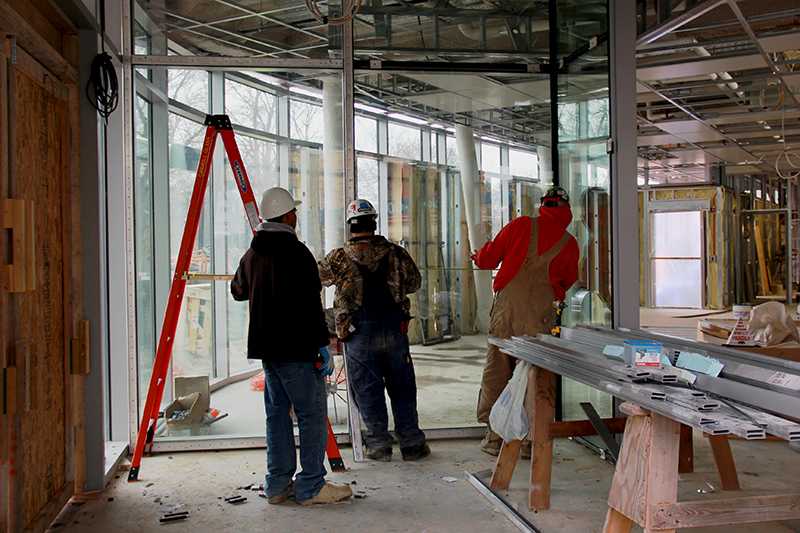Moody’s Downgrades College’s Credit Rating
Construction workers assess the situation within the new Lewis Gateway Center, which the College borrowed $18 million to build. The rating agency Moody’s Investors Services recently downgraded the College’s credit rating partially because of the College’s debt level.
December 4, 2015
The College has too much debt and depends too heavily on students for revenue, analysts from Moody’s Investors Service say.
Moody’s, one of the two most important credit-rating agencies along with Standard & Poor’s, downgraded Oberlin’s credit rating from Aa2 to Aa3 on Nov. 24.
Moody’s based its downgrade on the College’s relatively low endowment growth, dependence on tuition and high debt levels. The credit-rating agency anticipates that net tuition growth, which averaged 6 percent from 2011 to 2015, will fall in the near future and that the College will have to make adjustments as a result.
“Given management’s indication of more moderate net tuition revenue growth increasing revenue from other sources or more aggressively containing expenses will be critical to carry out its plan to reduce reliance on supplemental endowment draws in [ fiscal year] 2017 which have been used to support capital projects and the fundraising campaign expenses,” according to the report.
Moody’s also noted that the College’s ratio of total debt to operating revenue, 1.1, is higher than the median Aa-rated private university, which has a ratio of 0.8. The College gets 68 percent of operating revenue from student charges, higher than other Aa-rated institutions.
However, the agency also described the College’s financial outlook as “stable” and noted Oberlin’s “robust philanthropic support” and “consistently strong net tuition revenue growth” as two of the institution’s primary financial strengths.
Vice President of Finance Mike Frandsen said he did not anticipate the College’s borrowing costs would increase as result of the downgrade and noted that the College’s credit rating remains strong.
“First, even with the downgrade, Oberlin is still rated as ‘investment grade’ debt of ‘high quality and very low credit risk,’” Frandsen wrote in an email to the Review. “We are in good company with peers like Colgate, Macalester, Mount Holyoke and Wesleyan, among others, holding the same rating. Moody’s is just one rating agency. The other major agency, Standard & Poor’s, reaffirmed their AA rating of and stable outlook for Oberlin in August.”
When asked if he agreed with Moody’s decision, Frandsen was noncommittal.
“Similar to the U.S. News rankings of colleges, their methodology does not capture all the nuances of an institution’s finances. However, I think the rating generally reflects what I have been sharing in the presentations I’ve made to various campus groups over the last year.”
The report partially blames the College’s relatively elevated level of debt on “high capital investment,” including the Lewis Gateway Center currently under construction. The College borrowed $18 million of the $32 million overall construction costs.
According to Frandsen, the College’s current overall debt level, excluding the Gateway project, is $165.8 million, down from $170.4 million the year before.
Two students with financial expertise who read Moody’s report concluded independently that the College is overspending on major capital projects.
“It seems like Oberlin needs to focus a little more on investing in less capital-heavy ventures,” wrote Student Treasurer and College senior Miliaku Nwabueze in an email to the Review.
Benjamin Libbey, Student Finance Committee outreach coordinator and College senior, agreed.
“I think that the College needs to spend in proportion to its resources,” Libbey wrote in an email to the Review. “At the moment we are attempting to spend at a competitive rate but not saving and investing at a similar rate to our peers. Frankly, we have fewer financial resources than many of our peer institutions, and until this has been remedied we should not attempt to match their spending practices.”
















